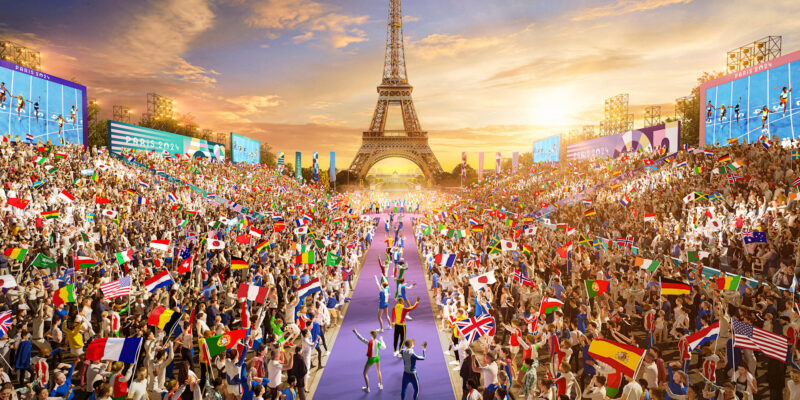The 2024 Olympic Games were not only a showcase of athletic prowess but also a testament to Paris’s ability to plan, construct, and deliver world-class infrastructure.
Hosting the Olympics is a massive undertaking that requires extensive preparation and significant financial investment. This blog delves into the construction efforts for the 2024 Games, highlighting what was built, the costs involved, the challenges their construction teams face, and the future of what will happen to these facilities.
What Was Built?
Olympic Village
The heart of the Games, the Olympic Village, was constructed to house over 10,000 athletes and officials from around the world. This complex included residential buildings, dining facilities, and recreational areas, providing a comfortable and secure environment for the participants.
Sports Venues: Several new sports venues were built, and existing ones were renovated to meet Olympic standards. Key projects included:
The Le Bourget Sport climbing wall arena, an open air venue that will remain after the completion of the games. Venue construction cost approximately $151 million USD.
The Aquatic Centre, built in Paris’ Northern suburbs for $190 million USD, has multiple pools and the ability to switch from a 5,000 seat venue (used for the Olympics) to a 2,500 seat venue for future events. It will remain open to the community.
The Porte de la Chapelle indoor arena for gymnastics, basketball, and other indoor sports was the only new venue built in the middle of Paris. Able to hold 8,000 spectators, it will also be home to power lifting and badminton at the Paris Paralympic games later this year. Construction costs came to $150 million USD.
Several other buildings were renovated to create specialized facilities for a wide range of sports like cycling, tennis, and the equestrian events
Transportation Infrastructure
To ensure the smooth movement of athletes, officials, and spectators, significant upgrades were made to Paris’s transportation network. This included new subway lines, expanded bus routes, and improved roadways. A new high-speed rail link connected the city center to the Olympic venues.
While transportation was initially hindered by arson attacks prior to the opening ceremonies, it soon returned to its planned schedules to transport over 6 million visitors to and around Paris.
Sustainable Initiatives
We’re always talking about sustainability at Steadfast Entities, LLC, and we were thrilled to see it was a key focus for the Paris games!
Several green initiatives were integrated into the construction projects, including solar panels, rainwater harvesting systems, and energy-efficient building designs that were implemented to minimize their environmental impact, both during the games and in the future. Thanks to these and other design features, the new construction generated 30% less carbon than traditional French construction.
Financial Investment
Hosting the Olympics is a costly endeavor, and the 2024 Games were no exception. The total expenditure for the construction projects was estimated to be around $7 billion. This included the costs of building new facilities, upgrading existing infrastructure, and implementing sustainable technologies. The budget was a mix of public funding, private investments, and sponsorships.
Challenges and Setbacks
Despite meticulous planning, several challenges arose during the construction phase:
Delays and Budget Overruns: Some projects faced delays due to unforeseen circumstances, such as supply chain disruptions and labor strikes. These delays led to budget overruns, necessitating additional funds to complete the projects on time.
Environmental Concerns: Environmental activists raised concerns about the ecological impact of some construction activities. Efforts were made to address these concerns, including reforestation projects and habitat restoration activities. Increased pollution levels in the Seine river also delayed several events, due to the water’s bacterial and chemical levels being too high for athletes to swim in it. However, it is notable that Paris is the first city to attempt to host a carbon neutral Olympic games.
Logistical Issues: Coordinating multiple large-scale construction projects simultaneously posed significant logistical challenges, resulting in additional traffic and noise across the city.
Post-Games Legacy
One of the critical aspects of Olympic planning is ensuring that the infrastructure developed for the Games continues to benefit the host city long after the event concludes. Here’s what lies ahead for the construction projects post-Games:
Olympic Village Conversion: The Olympic Village will be repurposed into affordable housing units and student accommodations. This conversion aims to address the city’s housing shortage and provide lasting social benefits.
Continued Use of Sports Venues: As mentioned previously, many of the sports venues will continue to be used for local and international sporting events, community programs, and recreational activities. This will help maintain the facilities and promote sports development in the region.
Transportation Infrastructure: The upgraded transportation network will continue to serve the city’s residents and visitors, improving connectivity and reducing traffic congestion.
Sustainable Practices: The sustainable initiatives implemented during the construction will serve as a model for both future urban development projects and upcoming Olympic Games, promoting eco-friendly practices and environmental stewardship.
If you’re working on an Olympic sized project, Steadfast Entities has the gold medal equipment and staffing you need to add to your team! We’re proud to offer state-of-the-art equipment at reasonable prices that will be earning you the highest scores on your next project. Contact us today so we can help you stick the landing and get the job done right, every time.

